Welcome to the August 1st, 2025 issue of Radio World


Welcome to the August 1st, 2025 issue of Radio World




• Stream provisioning, audio processing and metadata in one
• No Windows® drivers, updates or PC needed
• Audio processing optimized for streaming
• Easy HTML 5 web interface

• Stream for less

Staying alert on Orcas
Allen Hartle discusses his latest project.
Check out the latest codecs and STL products.




Vol. 49 No. 16 | August 1 2025 www.radioworld.com
FOLLOW US
www.twitter.com/radioworld_news
www.facebook.com/RadioWorldMagazine www.linkedin.com/company/radio-world-futureplc
CONTENT
Managing Director, Content & Editor in Chief Paul J. McLane, paul.mclane@futurenet.com, 845-414-6105
Assistant Editor & SmartBrief Editor Elle Kehres, elle.kehres@futurenet.com
Content Producer Nick Langan, nicholas.langan@futurenet.com
Technical Advisors W.C. “Cris” Alexander, Thomas R. McGinley, Doug Irwin
Contributors: David Bialik, John Bisset, Edwin Bukont, James Careless, Ken Deutsch, Mark Durenberger, Charles Fitch, Donna Halper, Alan Jurison, Paul Kaminski, John Kean, Larry Langford, Mark Lapidus, Michael LeClair, Frank McCoy, Jim Peck, Mark Persons, Stephen M. Poole, James O’Neal, T. Carter Ross, John Schneider, Gregg Skall, Dan Slentz, Dennis Sloatman, Randy Stine, Tom Vernon, Jennifer Waits, Steve Walker, Chris Wygal
Production Manager Nicole Schilling
Senior Design Director Lisa McIntosh
Senior Art Editor Will Shum
ADVERTISING SALES
Senior Business Director & Publisher, Radio World John Casey, john.casey@futurenet.com, 845-678-3839 Advertising EMEA Raffaella Calabrese, raffaella.calabrese@futurenet.com, +39-320-891-1938
SUBSCRIBER CUSTOMER SERVICE
To subscribe, change your address, or check on your current account status, go to www.radioworld.com and click on Subscribe, email futureplc@computerfulfillment.com, call 888-266-5828, or write P.O. Box 1051, Lowell, MA 01853.
LICENSING/REPRINTS/PERMISSIONS
Radio World is available for licensing. Contact the Licensing team to discuss partnership opportunities. Head of Print Licensing Rachel Shaw licensing@futurenet.com MANAGEMENT
SVP, MD, B2B Amanda Darman-Allen
VP, Global Head of Content, B2B Carmel King MD, Content, Broadcast Tech Paul J. McLane
Global Head of Sales, Future B2B Tom Sikes Managing VP of Sales, B2B Tech Adam Goldstein VP, Global Head of Strategy & Ops, B2B Allison Markert VP, Product & Marketing, B2B Andrew Buchholz Head of Production US & UK Mark Constance Head of Design, B2B Nicole Cobban

Future US LLC, 130 West 42nd Street, 7th Floor, New York, NY 10036
All contents ©Future US, Inc. or published under licence. All rights reserved. No part of this magazine may be used, stored, transmitted or reproduced in any way without the prior written permission of the publisher. Future Publishing Limited (company number 02008885) is registered in England and Wales. Registered office: Quay House, The Ambury, Bath BA1 1UA. All information contained in this publication is for information only and is, as far as we are aware, correct at the time of going to press. Future cannot accept any responsibility for errors or inaccuracies in such information. You are advised to contact manufacturers and retailers directly with regard to the price of products/services referred to in this publication. Apps and websites mentioned in this publication are not under our control. We are not responsible for their contents or any other changes or updates to them. This magazine is fully independent and not affiliated in any way with the companies mentioned herein.
If you submit material to us, you warrant that you own the material and/ or have the necessary rights/permissions to supply the material and you automatically grant Future and its licensees a licence to publish your submission in whole or in part in any/all issues and/or editions of publications, in any format published worldwide and on associated websites, social media channels and associated products. Any material you submit is sent at your own risk and, although every care is taken, neither Future n or its employees, agents, subcontractors or licensees shall be liable for loss or damage. We assume all unsolicited material is for publication unless otherwise stated, and reserve the right to edit, amend, adapt all submissions.
Radio World (ISSN: 0274-8541) is published bi-weekly by Future US, Inc., 130 West 42nd Street, 7th Floor, New York, NY 10036. Phone: (978) 667-0352. Periodicals postage rates are paid at New York, NY and additional mailing offices. POSTMASTER: Send address changes to Radio World, PO Box 1051, Lowell, MA 01853.
Please recycle. We are committed to only using magazine paper which is derived from responsibly managed, certified forestry and chlorine-free manufacture. The paper in this magazine was sourced and produced from sustainable managed forests, conforming to strict environmental and socioeconomic standards. The manufacturing paper mill and printer hold full FSC and PEFC certification and accreditation.
Allen Hartle explains the dual purposes of this new LPFM

Paul McLane Editor in Chief
IXP is a new low-power FM radio station that has just gone on the air in Eastsound, Wash., on Orcas Island in the San Juan Island archipelago, near the Canadian border.
The licensee is StayAlert. Its business plan for the station comes with a twist: In addition to airing community programming, the non-profit service uses both the LPFM station and a Class C FM neighbor to broadcast alert messages. The LPFM uses standard RDS to place alerts in the car dashboard, and the full-power station uses StayAlert’s RDS2 open data application to carry alerts to public kiosks and personal data receivers at remote island locations not served by traditional infrastructure.
I asked President Allen Hartle to tell us more.
Allen, many readers will know you from your work over the years at The Radio Experience, Broadcast Electronics and Jump2Go. What is StayAlert.org?
Allen Hartle: StayAlert is a Washington state non-profit founded by me and my wife, Liberte Pedicini. Its core mission is dedicated to serving public safety by developing emergency alerting technology based upon the RDS and RDS2 data standards. We are also interested in revising U.S. RDS/HD Radio metadata standards and practices with a focus on reducing potential driver distraction.
We began with installing our equipment on a partner station, 63 kW Class C station KWPZ, licensed to Crista Ministries. Its chief engineer, Aaron Hume, as well as Tim Vick and Garrett Duguay contributed significantly.
The RDS- and RDS2-compatible software and hardware was created by my dear friend and collaborator Joop Beunders. He was one of the creators of RDS and the new RDS2 standards. Before he passed away, he asked me to carry on his legacy of work regarding RDS, RDS2 and alerting.
Now StayAlert has launched its own LPFM station. What is its format?
Hartle: The “Community” format is a station completely dedicated to the San Juan Islands community. We have an unusually large number of creative people who’ve chosen to live here. Our music library consists of close to 7,000 songs from artists connected to the islands.
Now that the heavy lifting is done and the signal is on, we are organizing volunteers who will produce original programming. KIXP will feature local history and the many people that play a major role in the community’s past/ present/future.
We are also connected with the local history museum, The Orcas Center performing arts organization, fire and rescue and any non-profit that requests
Continued on page 14
Fabrice Polynice, also known as DJ Paz, is challenging the constitutionality of a $2.4 million pirate radio penalty.
Polynice says the fine is not only beyond his financial means but also violates his Seventh Amendment right to a jury trial, a claim he believes is bolstered by recent landmark court decisions.
He was fined for operating “Radio Touche Douce” from North Miami, Fla., in February and March of 2023, though the commission said he operated the station since at least 2012.
In 2020 Congress gave the FCC the authority to impose significant financial penalties on operators of illegal unlicensed radio stations. In his challenge, Polynice cited the Supreme Court decision in SEC v. Jarkesy among other legal arguments.

Separately a longtime unlicensed operator in Massachusetts agreed to a consent decree, resulting in a much-reduced civil penalty.
Jean Marius had been issued a forfeiture of about $597,000 for operating “Radio Tele Planet Compas” for more than two decades. He appealed based on an inability to pay. The Enforcement Bureau confirmed that he was no longer operating the station and proceeded with a consent decree in which Marius must pay a civil penalty of $10,000 and promised not to resume broadcasting at the risk of having the original penalty imposed.

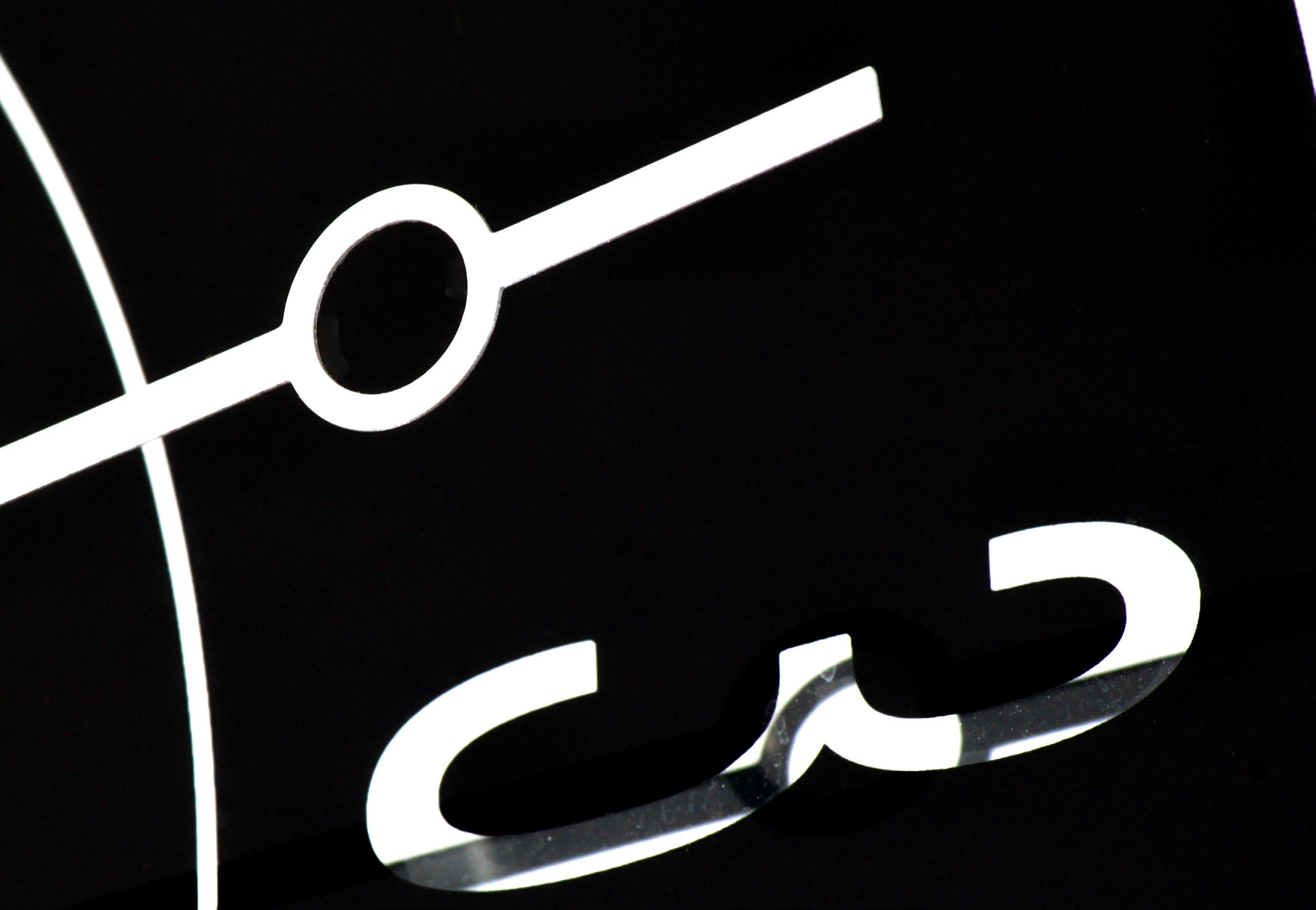
Writer

Randy J. Stine
Nielsen’s recent notable tweak to its radio audience measurement process has brought significant changes to the ratings landscape in many major U.S. radio markets. The early returns show promise for broadcasters, though industry experts say it’s too early to make final determinations.
Since late last year, radio stations in the 48 markets where the Portable People Meter is used now receive full credit from Nielsen after just three minutes of listening per quarter hour instead of five. Diary-based markets still use five minutes as a standard.
The new measuring stick is still novel, but experts say several trends and key findings can be identified.
More short listening sessions are being credited following the changes, Nielsen says. But as one radio analyst put it:
“Radio isn’t growing. Nielsen just changed the rules. And stations will take it.”
Rich Tunkel, managing director at Nielsen Audio, said the company expected that every station would have more reported audience with the move to the three-minute qualifier, but that results have varied based on the market and stations involved.
“For individual stations, the gains in audience are coming from higher daily cume audiences, which is what drives higher AQH,” he said.
“The playbook to grow audience hasn’t changed: Grow your daily cume. The way to do that is to entice new listeners every day and give reasons for existing listeners to show up more consistently.”

Above Rich Tunkel. “The playbook to grow audience hasn’t changed.”
Right Pierre Bouvard.
“This is truly a case of the rising tide raises all boats.”
Tunkel says one misconception broadcasters have is that every radio segment now needs to be shorter and that stations need to change up their content into threeminute chunks.
“That is not the takeaway you want to get from this change. When Nielsen examined the radio listening behavior that led us to modify the qualifier, we saw that about half of radio occasions are shorter than five minutes and the majority of those short segments are three minutes long. But it doesn’t mean radio programming needs to be anchored to that.”

Instead, Tunkel says it just means broadcasters should be aware that listeners are constantly coming in and out of listening, so stations should be consistent in delivering
“You don’t have much time to impress the audience before they leave. You may want to reset the segment and welcome new listeners more frequently, but some of the most compelling radio lasts as long as it needs, and that can be far longer than three minutes. Broadcasters
shouldn’t get too narrowly focused on our qualifier rules when it comes to delivering compelling content.”
However, Tunkel says shorter durations of content might make it easier for those “snippets” to be reposted, placed on social media and released by broadcasters as highlights on digital platforms.
Another trend is the higher impression levels that radio is delivering in advertising campaigns. In other words, the media plans put in place by advertisers six or 12 months ago are now overachieving.
“We are seeing that campaigns bought off of the old data are delivering at higher total audience levels, which means fewer shortfalls and fewer makegoods,” he told Radio World.
“That is a trend that will likely only exist in 2025 and until campaign targets are reset. But higher impression levels for advertisers will persist for some time, showing the contribution of more listening in their market mix models.”
Broadcasters clearly are eager to start digging into the latest Nielsen ratings data reflecting the change.
Pierre Bouvard, chief insights officer for Cumulus Media/

Westwood One, said this “enhanced” crediting solution has generated audience growth for the Cumulus stations across all demographics, ethnic groups, dayparts and programming formats.
“This is truly a case of the rising tide raises all boats,” Bouvard said.
The most surprising finding for Bouvard has been the wide differences in growth by market. “Some of that might have to do with unique listening shifts or local events that occurred in some of the local markets,” he said.
“Radio isn’t growing. Nielsen just changed the rules. And stations will take it.


Cumulus also has found a “positive response” to the shift from advertising agencies.
“In a world where digital ads are considered viewable with two seconds of exposure, shifting radio credit-listening from five minutes to three minutes is seen as a logical move. Media planners expect this shift will cause radio’s audience delivery to become even stronger than that of television.”
Bouvard said ad agencies have been excited to see that radio ad campaigns now generate greater reach and frequency.
However, he said many larger national advertisers are waiting for Nielsen’s spring 2025 book, to be published this summer, to see how it reflects the impact of the threeminute enhanced edit rule.

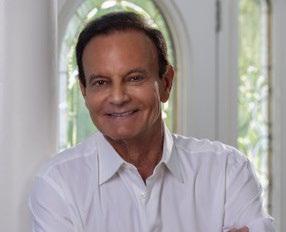
Joel Raab, a country radio programming consultant who works with Beasley and Bonneville, says the change in quarter hour accreditation shows promise, but it might be too early to determine how much it will deliver.
“It’s hard to draw any hard conclusions, but anecdotally, we have seen cume climb in certain formats like country and CHR. At the same time, time spent listening appears to have dropped a bit,” Raab said.
Raab says he has heard about some broadcasters shifting stopsets a bit deeper into the quarter hours to take advantage of the ratings shift.
Despite the rule change, Raab says some of the smaller PPM markets are “very susceptible to waffles in the ratings. The change in methodology in how they collect that data really doesn’t change that fact.”
There might be another format winner as a result of the change in listening measurement.
Longtime radio industry blogger Jerry Del Colliano says public broadcasters are benefitting from the change.
“Shorter listening sessions now get counted, and NPR benefits, especially among newsfocused and drive-time listeners,” Del Colliano wrote on his Inside Music
Top Fred Jacobs: “Sadly, that time-honored relationship between ratings and revenue is no longer a guarantee of success.”
Above
Jerry Del Colliano. “Shorter listening sessions now get counted, and NPR benefits, especially among newsfocused and drivetime listeners.”
Below
Joel Raab says that smaller PPM markets remain “very susceptible to waffles in the ratings.”

Media blog. “Those airing NPR news magazines like ‘Morning Edition’ or ‘All Things Considered’ tend to attract highly habitual listeners who check in for headlines at the top of the hour.”
Even though radio broadcasters are desperate for good news, there are those who question whether the switch to the three-minute qualifier will be a boon for radio ratings and revenue.
Fred Jacobs, president of consulting firm Jacobs Media, says shifting format performance in the Nielsen three-minute world may be short-lived and deceiving.
Radio, he says, has chased meters “often to its own detriment, and I worry that radio is once again fixing the wrong problems.”
Jacobs recalls when PPM meters entered the industry.
“Too many pundits made conclusions that PPM was good and bad for various formats. While smooth jazz vanished forever, everyone else settled into simply doing the best they could, whether they were music, spoken word, Hot AC or country stations.”
Jacobs says he questions whether ratings increases due to three-minute improvements will make a demonstrable difference in a radio station’s fortunes.
“I’m not suggesting ratings don’t matter [but] sadly, that time-honored relationship between ratings and revenue is no longer a guarantee of success.”

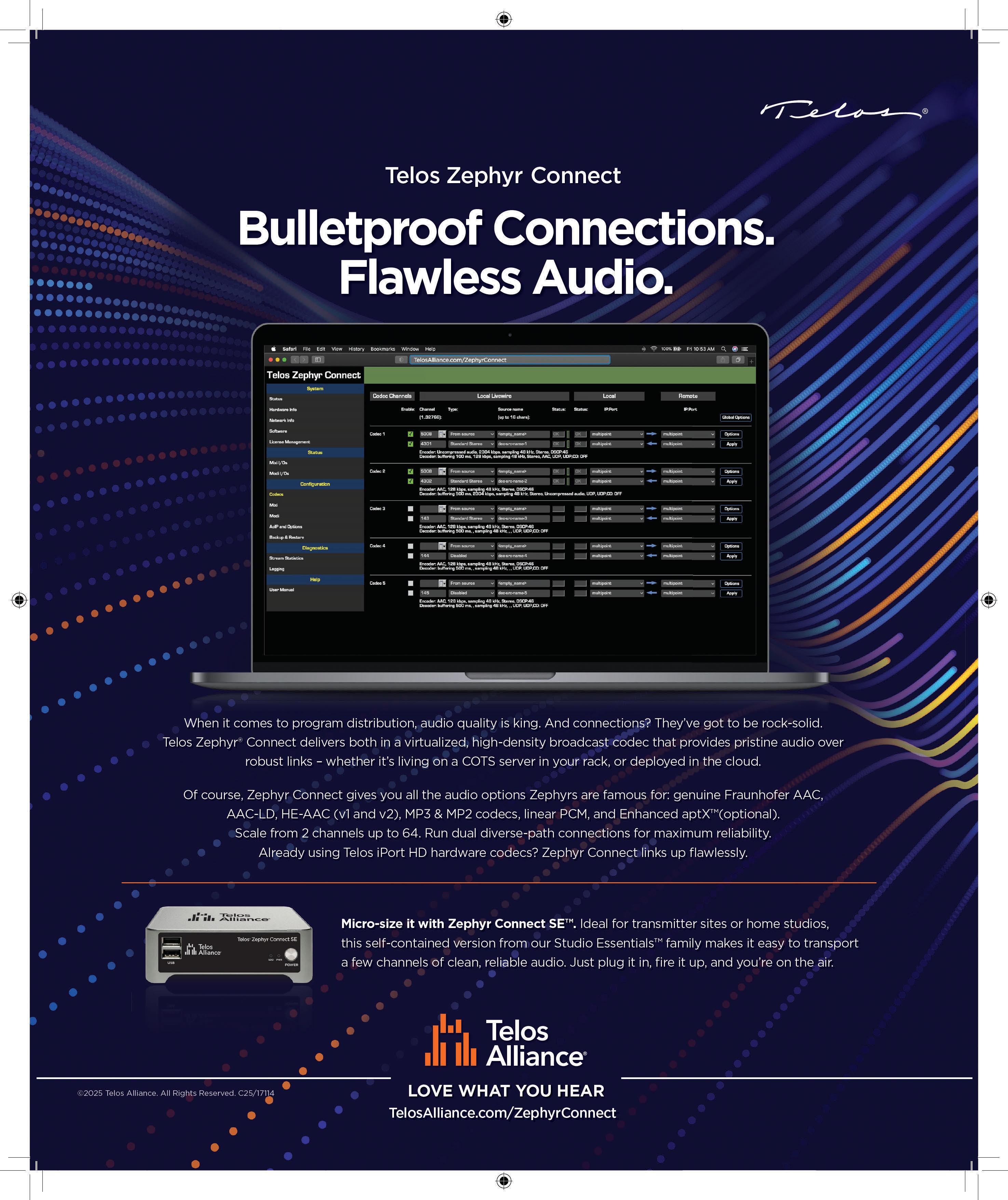

The author is in his 34th year of writing Workbench. He handles western U.S. radio sales for the Telos Alliance and is a past recipient of the SBE’s Educator of the Year Award. . Send your tips Workbench submissions are encouraged and qualify for SBE recertification credit. Email johnpbisset@ gmail.com.
Give it some attention and treat it with respect
That big orange, green or gray box sitting outside your transmitter building is easy to forget. It just works — as long as it’s maintained.
Money spent on a contract with a local generator service company is well spent. However, budgets being what they are, such service may be one of the first expenses cut by management.
Here are maintenance tasks that you can perform to help keep your generator in reliable operation. Like a car, your generator needs routine maintenance if it is to perform reliably. A good rule of thumb is to inspect it quarterly. Pair it with your quarterly tower inspection.

If your generator has been in service in an emergency, also inspect it after every 150 hours of operation. If it has been running, it’s also helpful to know the fuel consumption. One of the most embarrassing things to explain to management is that your generator kept your station on the air but then stopped because it ran out of fuel.
Identify several sources of fuel now — don’t wait for an emergency. Meet with these providers. Take them some

them; swap emergency contact names and cell numbers. Write it all down and post it at both the transmitter site and at the studio. Give the information to the station general manager and operations manager too. The goal here is to avoid surprises.
If your generator is powered by diesel fuel, purchase a container clearly marked for diesel fuel, as pictured in Fig. 1.
Before you get inside, scrutinize the outside of the unit. Are there hole plugs missing, as seen in Fig. 2? If so, fill them with wads of stainless steel wool, which doesn’t rust, until you can obtain replacement hole plugs.
Vegetation on a generator can restrict air flow and attract vermin, including snakes. Remove growth from around or atop the unit. Consider creating a perimeter of crushed stone atop a fabric weed barrier.
After inspecting the exterior, disable the generator at the control panel and throw the breaker. You don’t want it to start while you are doing your tests and inspections.
Look inside with a bright light, searching for leaks. Check fluid levels including oil, fuel and coolant, and add them as needed.
Wipe down the bottom of the generator — a clean interior will help you identify problems over time. Observe the exhaust system — no restrictions, right? Look to make sure there are no holes in the exhaust pipe.
Compatible with today’s hardware EAS AND future Software-based EAS implementations
The 677 Triple Tuner is compatible with both today’s EAS hardware solutions and future Software-based EAS implementations. Inovonics has added 3 simultaneous audio streams for Software-based EAS, adding longevity to your investment in the 677.


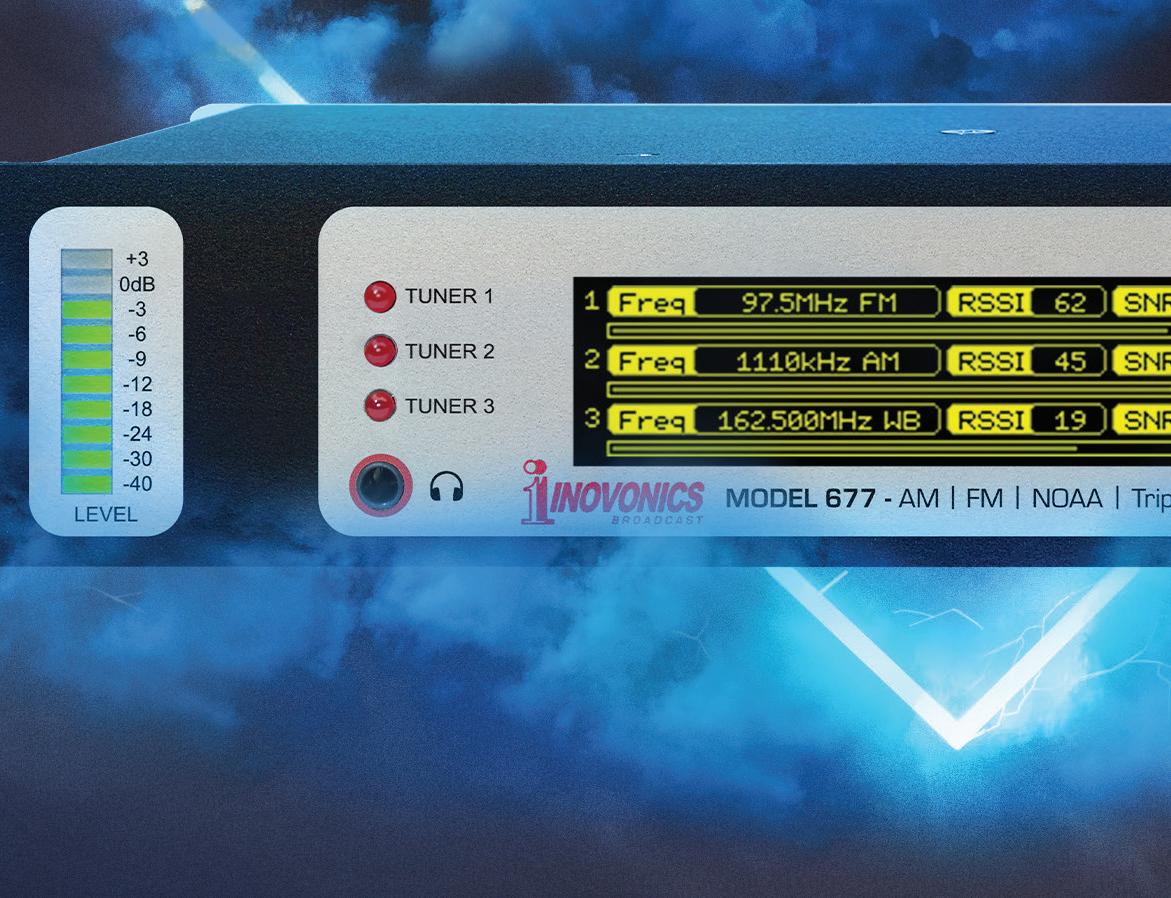
Field tested and ready to go after an exhaustive Beta testing program with respected Radio Engineers in the industry. The all-digital 677 has three discrete and independent receivers for any combination of AM, FM, or WB reception and monitoring. Each 677 receiver has o -air antenna inputs and balanced monaural XLR outputs.

▪ Easy front panel set-up via jog wheel with LED readout and metering.
▪ User-friendly management via Web interface from any Web enabled device.
▪ Software-based EAS ready. Full-time Web stream on all three receivers.
▪ Selectable remote listening by Web Stream.
▪ Alarms & notifications by email or SMS and full SNMP support.
▪ Six rear-panel GPOs may be user-assigned to alarm functions.
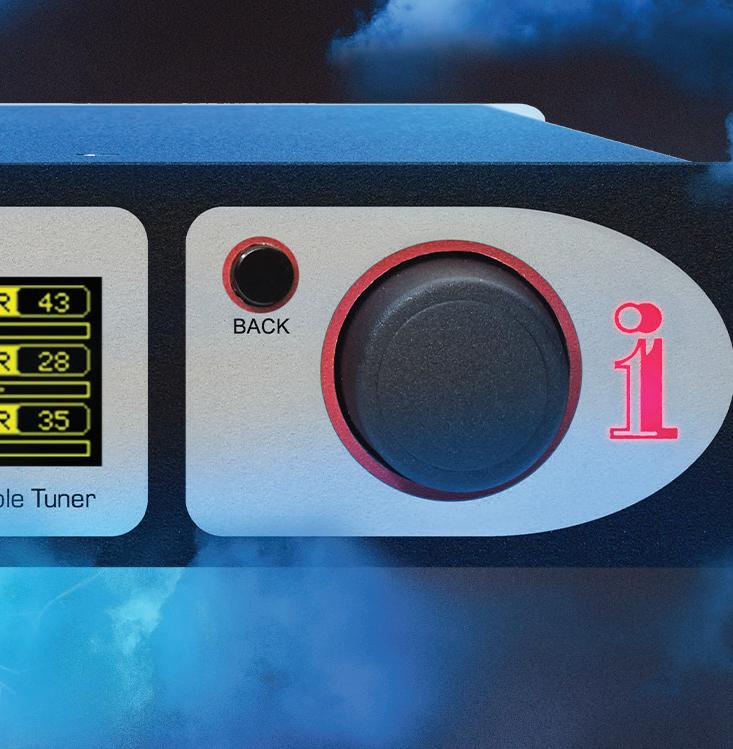


The 677 Triple Tuner is a fantastic little box that reveals how Inovonics continues to listen to and support the needs of the industry. “ ” JEREMY PREECE








Speaking of restrictions, check that there are none in the ventilation system. Leaves and nests can cause blockages. If you live in cottonwood country, the air is filled with fluffy cottonwood seeds from March to June. Those seeds are drawn to the air intakes on generators, air conditioners and fan systems.
Consider installing hardware cloth over the ventilation intake point of the generator. The cloth won’t keep the bees out but it will discourage mice and lizards.
Wipe down the battery cables and inspect the connections for a tight fit on the terminals (Fig. 4).
Remember that the generator is run by a motor that vibrates, which can loosen connections. Make note of when the battery was replaced and the type. Lead-acid batteries, the most commonly used, last about three years. Absorbent glass mat (AGM) batteries can run up to four to five years. Lithium-Ion batteries can last up to seven.
Your battery life may vary, but if you have a six-yearold lead-acid battery, you probably are running on borrowed time.
After checking the coolant level, wipe down the coolant hoses. Check for bulges, which indicate weakness. Then squeeze the coolant hoses with your thumb and forefinger, looking for cracks or brittleness in the rubber; these are a precursor to failure.
Rubber hoses have a lifespan of five to 10 years, but high heat degrades rubber. According to AutoZone, higherquality rubber hoses are worth the expense.
While you’re inside the enclosure, check all the control wiring and their connections. This includes wiring to the alternator. Again, make sure connections are secure.
The most common problem here is mice chewing on wire assemblies. In addition to sealing entry points, consider adding a pouch or two of Bonide Mouse Magic, which is found in most hardware stores and available online. These little pouches of essential oils are pleasantly fragrant to humans and are great to discourage mice and snakes. They also work well in a transmitter building and the base of an antenna tuning unit.
Once a year, replace the spark plugs and air filter.
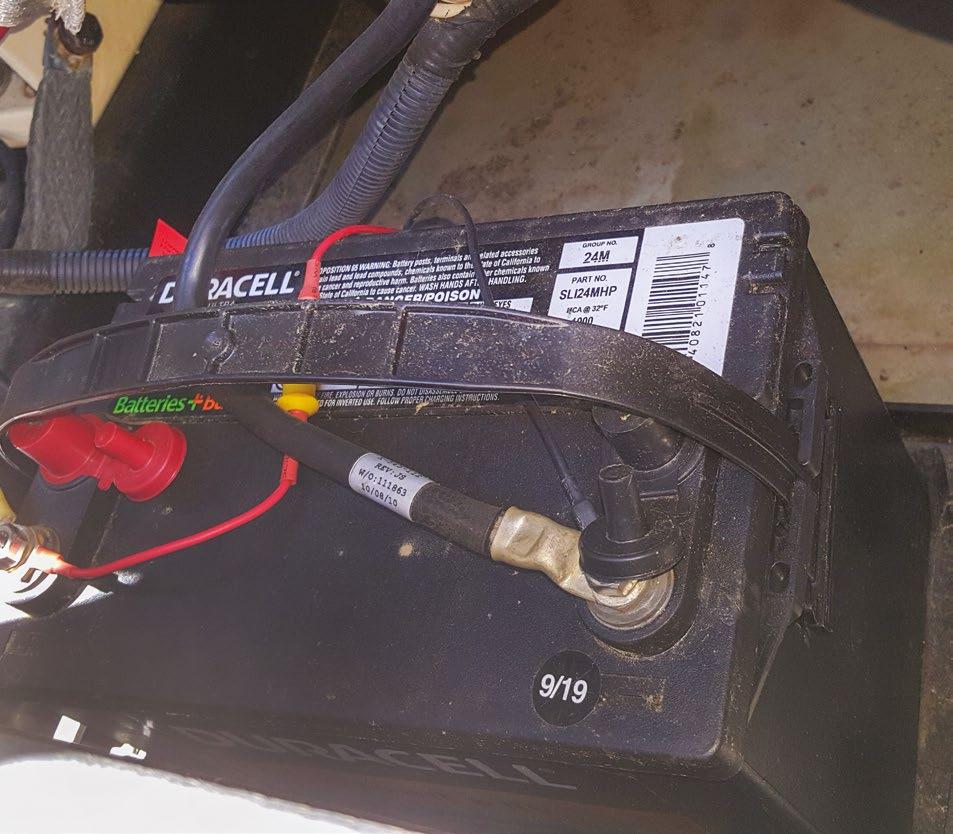

As you wrap up the maintenance, operate the generator. Check the automatic changeover and that the circuit breaker is on. At the end of your test, look again for leaks as well as any alarms on the control panel.
Knowing that your generator is in good shape and ready to run brings peace of mind. Do you have tips on maintaining generators? Send them to me at johnpbisset@ gmail.com

Below Allen Hartle, right, and his wife and station co-founder Liberte Pedicini sit with the PSI antenna at a community farmers’ market prior to installation.
“Having an FM station is a big deal here,” Hartle told us.
Continued from page 3
promotion. Online, we will assist local businesses with traditional advertising via underwriting and digital media.
How does this station advance the goals of StayAlert?
Hartle: Technical redundancy, for starters. Our Class C partner is one regional signal. With the addition of KIXP, Eastsound now has two FMs providing StayAlert data. Additionally, the local in-car RDS displays StayAlert data in the receiver as well as our planned kiosks.
Key citizens of Eastsound are involved in the project and the new StayAlert resource it represents. Our island community is isolated, using a few underwater cables for electricity/telephone and Internet. Ferry boats are our main source of transportation. Our local non profits significantly take care of our residents in need, and having StayAlert live data installed at their public gathering facilities will be part of that.
Having KIXP also is super valuable as a test bed, where I can combine 30 years of RDS experience and products with
the new StayAlert technology. I’ll be working with the major middleware companies, seeking integration collaboration. I should mention the Cascadia Subduction zone, a major fault line off the Pacific Northwest coast, stretching from northern California to Vancouver Island. It’s a convergent plate boundary capable of producing powerful earthquakes, including “great earthquakes” of magnitude 9.0 or higher, and subsequent tsunamis. The last major earthquake on this fault was in 1700 and is overdue.
I look at StayAlert as a potential “tsunami alert system,” needed by the states of Washington and Oregon and by British Columbia. More than 43 tsunami structures are proposed for construction across coastal areas at a cost of $40 million. That would buy a LOT of RDS encoders!
Please describe the air chain.
Hartle: I built the studio downtown — in the likeness of Northern Exposure but better — with our beautiful Pacific Recorders AMX-22 legacy console in the front window.
Seattle radio legend Bruce Murdock and his lovely wife
“More than 43 tsunami structures are proposed for construction across coastal areas at a cost of $40 million. That would buy a LOT of RDS encoders!

donated that epic console and drove it from Seattle to the islands, delivering it into our studio space.
I am trying to keep everything as simple as possible, in order to involve the community as the organization develops. We use Nextkast radio automation. It’s powerful yet easy to use, and I love being able to talk to the developer Winston Potgieter. He’s a brilliant man with a powerful product and included metadata support for my Jump2Go JumpGate.
I can’t afford the time to have the automation or any sub system become a burden to operate. There just aren’t enough hours in the day.
We chose an Ecreso AiO series transmitter from our longtime RDS collaborator Worldcast Systems. The transmitter lives downtown at the studio. It is easy to learn and operate, including the

built-in audio processing. Not having any direct competitors frees us from loudness considerations. We pick a preset and get on with our day. We have a clean and undistorted sound on the air.
The studio rooftop antenna was required to be directional, so engineering consultant Bert Goldman recommended Propagation Systems, which was a great decision. Bert and attorney Ernest Sanchez were invaluable in preparing the application. Even the FCC was helpful to us in preparing our application so we could serve our community.

RDS encoders are provided by Inovonics. Ben Barber continues to be the nicest guy in radio and contributed considerable time and resources to making sure the Inovonics 732 supported our project.
RDS2 encoders are by Worldcast. Christopher Poulain and team do their best to answer my questions as we work towards developing next-generation RDS2 applications.
The website mentions expansion plans for the station.


promotional image of the studio.
Hartle: They are TBD. Whether we’re talking about translators or boosters, we have seven other island communities that could benefit from KIXP expanding. All locations have our island-wide Rock Island gigabit internet service, so there will be no challenges getting the audio there. I’m looking forward to hearing about future FCC filing windows.
What else should we know?
Hartle: I couldn’t have gotten this far on this project or any other without help from others. Broadcast engineers are still my favorite people. How many people do we know who conduct their lives with a “failure is not an option” attitude?
I want to send a shout out to my lifelong friend and mentor Martin Hadfield, who’s responsible for believing in my various projects and lending a hand when needed. He is also responsible for kicking off acceptance of RDS in the U.S. as the technical director of Entercom.
And don’t forget John Casey, who today is the publisher of Radio World. He reached out to me to suggest that we use RDS for our billboard projects — that was in 1993!
























The Buyer’s Guide section appears in every other issue, focusing on a particular category of equipment and services. It is intended to help buyers know what’s on the market and gain insight into how their peers are using such products.
As chief engineer of Audacy’s five FM station San Diego cluster, Bill Eisenhamer is responsible for technical coordination of the San Diego Padres’ radio broadcasts.
Audacy’s 97.3 KWFN(FM) is the Padres’ flagship station.
KWFN’s primary signal covers San Diego, with the aid of four booster signals. The Padres’ network also has affiliates in Temecula, Palm Springs and Las Vegas.
“My philosophy is that flexibility and reliability are critical,” he said.

Some time ago, the station cluster opted to use Tieline codecs. Today, it has approximately 24 Tieline codecs, six of which are ViAs that he described as the “workhorses” for the five stations, along with three Merlin Plus units.
The stations also use Tieline Gateways for inter-studio links and sports-related feeds, as well as several firstgeneration Bridge-IT and Bridge-IT XTRA codecs.
Prior to opening day of the 2025 MLB season, Audacy installed a new Tieline Bridge-IT XTRA II codec in Petco Park’s broadcast booth rack.
Eisenhamer called the setup “semi-permanent,” as it replaced an older codec due for an upgrade. From Petco Park, stereo program audio is sent to a studio-based Gateway 8 using Tieline Music Plus encoding. The same Gateway distributes mono feeds to network affiliates and connects to a ViA codec for away games.

In rare instances, the network used Opus to accommodate poor internet connectivity at remote sites. Because of the need for redundancy, the Padres’ network uses SmartStream Plus. The Bridge-IT is programmed using both NICs independently. The Gateway at the studio has two independent ISPs,
with one of its NICs being internal. NAT translation is used, Eisenhamer said, while the other setup is a DMZ host. “If we lose one, we will not lose our full broadcast,” he explained.
On one channel of the stereo return, the network sends mono program and IFB communications, while the second channel is a produced play-by-play feed routed to the Petco Park control room, which feeds the stadium’s common areas.
Audacy San Diego also uses Tieline’s Cloud Codec Controller for remote codec management, which Eisenhamer said makes it easy to change or troubleshoot an issue.
He also appreciates the accessibility of the setup. He noted menu access with the Bridge-IT XTRA II’s front panel, helpful if a technician does not have computer or remote access.
“We all like web-based access, but sometimes having buttons can save the day,” Eisenhamer said.
All of the codecs back at the studio, he said, are connected to an SAS system via AES digital audio. Eisenhamer said he has tested a Gateway using a Dante module, which he said has worked well and may be implemented in the future.
Eisenhamer sees future expansion to include AES67 networking to add more flexibility in the Padres’ booth. Because of the Bridge-IT XTRA II’s dual AoIP ports, he sees the upgrade being simple to complete.
In 2004, Thimeo released Stereo Tool, a software-based FM audio processor.
Hans van Zutphen, the company founder and CEO, said the product became quite popular, but the key innovation was its composite clipper.
“It gave stations the ability to be 2 to 3 dB louder while sounding cleaner,” he said.
He discovered that some customers were not using the clipper because they did not want to put the processor at their transmitter site. Instead, they would send the signal out with left and right audio. “That removes all the benefits from composite clipping,” he said.
His proposed solution would allow a station to send a composite signal to the transmitter. With that in mind, van Zutphen started working on a type of codec designed for FM transmission that could send a full composite signal at relatively low bitrates without noticeable artifacts.
“This is how MicroMPX was born,” he said. The technology was introduced in 2016. He said the industry response surpassed his expectations. In addition to implementing MicroMPX in its own product line, Thimeo licenses it to other manufacturers.
MicroMPX has the same characteristics of FM transmission, meaning artifacts are blended into the signal, masked by


FM reception. With traditional codecs by contrast, van Zutphen said, FM noise and codec artifacts can be audible.
The benefits include reducing high-cost fixed transmission lines and increasing loudness while having a clean signal. The technology also supports single-frequency networks, allowing networks to provide the same signal to multiple locations.
Thimeo has since introduced MicroMPX+, which supports bitrates as low as 176 kbps, making it suitable for satellite delivery.
Info: www.thimeo.com

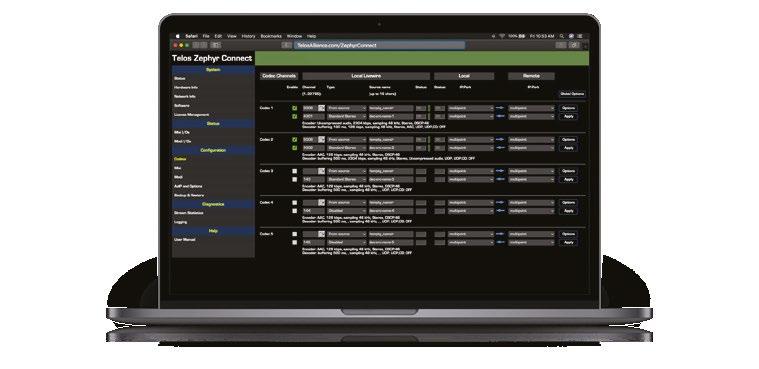


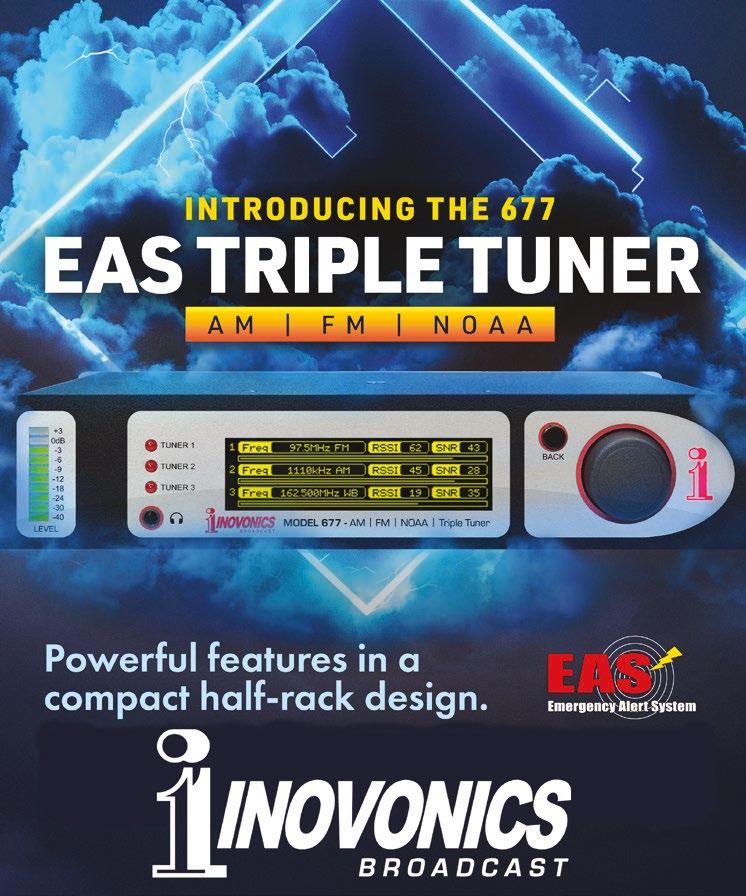

A makeover of its audio infrastructure fits into three rack units
In 2023, the Australian Radio Network embarked on a relocation of its head office and flagship studio operations to a new facility in the heart of Sydney. With the move came an engineering challenge: how to deliver a reliable, scalable audio infrastructure that could support the complex needs of a modern media network.
Working with integrator AVC Group, ARN identified the Telos Zephyr Connect virtual codec for its new studio complex. Greg Hateley, the broadcast technology architect for ARN, said it has enabled the network to simplify what would have required a sprawling array of hardware.
He said that the Zephyr Connect has been adaptable to ARN’s needs. Each of its program instances can scale to as many as 64 bidirectional stereo codecs, with an individual bitrate and codec algorithm. Options include AAC-LD, AAC-HE, AAC-HEv2 and MPEG AAC Fraunhofer, along with backwards compatibility for MP3 and MP2 formats. Enhanced aptX coding is also available.
The new Sydney facility includes multiple studios that require the use of multiple virtual mixers with custom channel manipulation and codecs. In a conventional setup, Hateley said this would have consumed significant rack space, increased the power draw and placed a heavy load on the network’s LAN infrastructure. With Zephyr

Connect, he said the ecosystem requires just three units of rack space.
More Info www.telosalliance. com
What makes the Zephyr Connect future-proof, Hateley said, is its virtualized software deployment. He said its architecture allows the network to deploy its services across its newly completed Sydney studio complex.
AEQ has released Solaris, a high-density multi-codec IP gateway for broadcast environments. The company says it maintains broadcastquality audio from 20 Hz to 20 kHz.
Solaris is designed for STL links, remote contributors and audio distribution. It is scalable in groups from eight bidirectional stereo

The gateway is housed in a 1U chassis with an IP-based architecture and support for Dante/AES67. It includes up to five Ethernet interfaces to separate encoded audio, control and AoIP traffic, which enables configurations with physical and logical redundancy. It supports G.722, G.711, PCM and Opus codecs, with optional support for AAC and aptX, along with advanced FEC correction mechanisms and automatic clock synchronization.
The system is controlled via a web interface or through SNMP and API protocols. Its design allows for rack installation with passive cooling for silent operation.
Info: www.aeq.eu
MaxxKonnect has released a 950 MHz point-to-point STL system.
The system comprises a UST950 transmitter, shown, and USR950 receiver. It is equipped to send mono analog audio or stereo MPX audio. It can be configured with optional cards for the transmitter and/or receiver to ingest analog L/R audio or AES audio (32 kHz or 48 kHz).
The STL comes equipped with a web-based user interface and SNMP controls, in addition to contact closure outputs, allowing for flexible remote monitoring. STL frequency and transmitter power level can be configured through the web interface, and email alerts can be set to detect silence or an inactive RF field. Similar parameters for the receiver can be configured, as well as detection for signal receive level and frequency drift.
The transmitter is capable of outputting up to 15 watts, while the receiver can detect levels as low as 7 uV. The actual deviation of the transmitter is selectable between 5 kHz and 75 kHz, which MaxxKonnect said is suitable for a noisy or congested signal path.
The transmitter and receiver have 24V DC power inputs that include a built-in float charger. They each also support external batteries. At a demonstration at this year’s NAB Show, the STL remained powered by a 24V battery system even after its main 120V AC power source was disconnected.
Info: www.maxxkonnect.com

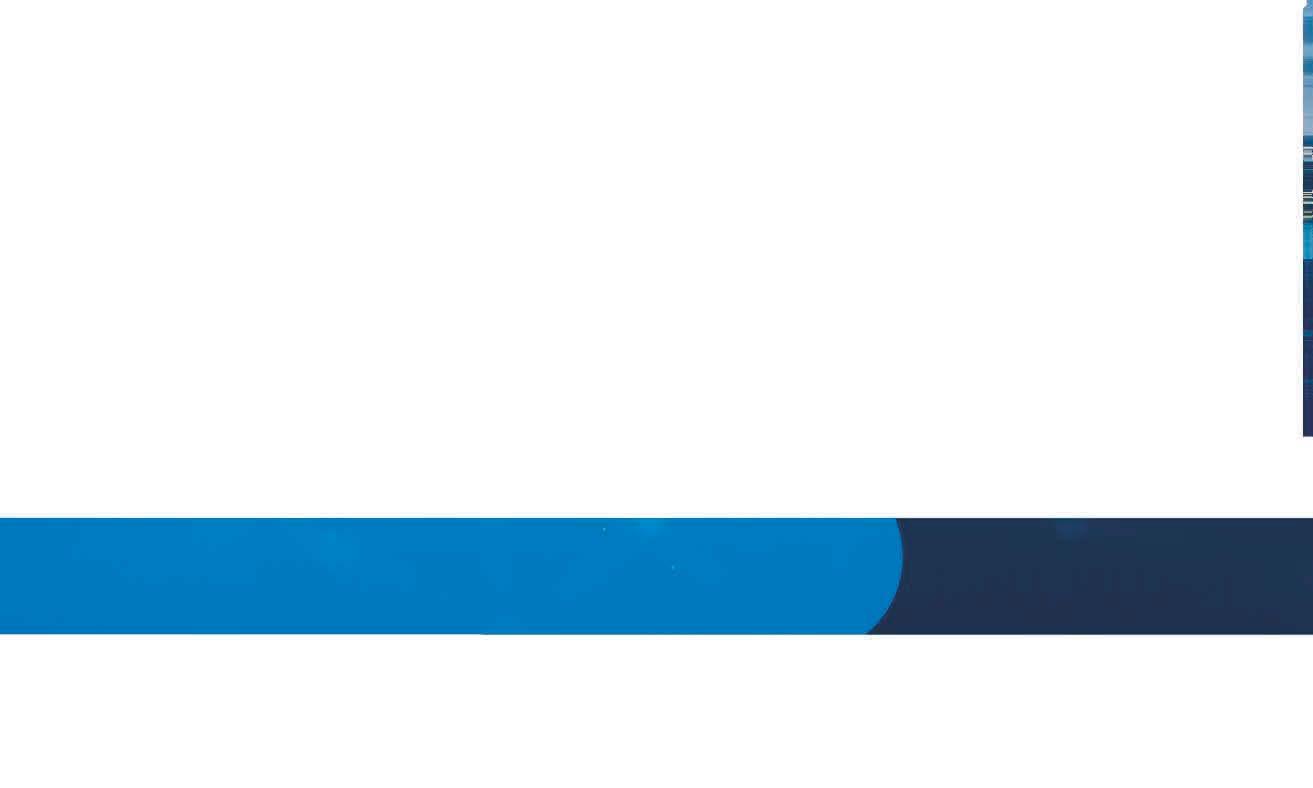


The French network 100% Radio, which broadcasts a contemporary hits format with regionally focused content, operates 16 separate program feeds across 50 FM frequencies and 16 DAB+ frequencies, according to its website.
As the network expanded, challenges mounted as it tried to scale efficiently with hardware-heavy infrastructure. Each feed required dedicated audio processors at multiple locations. The network said it became harder to guarantee consistent audio quality across its locations.
Seeking a more agile and centralized approach, 100% Radio identified WorldCast Systems to adopt a virtualized MPX over IP transport from the studio to its multiple transmitter sites.
Now, the network said it uses a software-defined architecture
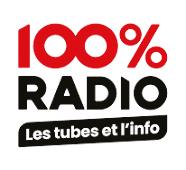
powered by APT IP codecs and APTmpX technology.
Audio processing for each feed is handled in the 100% Radio studio using Omnia.9 software processors. Their MPX outputs are routed directly to the virtual APT IP codec in a containerized environment.
The virtual codecs perform MPX compression and transport using APTmpX. The three-format approach this offers allows sound integrity while reducing bandwidth usage at each site.
The network said it uses several kinds of transmitters. For legacy models, the MPX over IP stream is decoded by an APT Silver Decoder with a BNC output to feed the existing transmitter via analog MPX.
It has also transitioned several of its sites to WorldCast Systems Ecreso FM AiO Series, in which the APT IP decoder is already built-in as software.
Any packet loss, 100% Radio said, has been effectively mitigated by enabling APT SureStream’s built-in redundancy. It said that even with a single IP path, reliability improved significantly. It also cited the resilience within the APTmpX algorithm.
The setup is monitored through Kybio, WorldCast’s vendoragnostic platform.
As the French network looks to continue to expand throughout the country, it believes it has both simplified its infrastructure and future-proofed its operations without sacrificing quality.
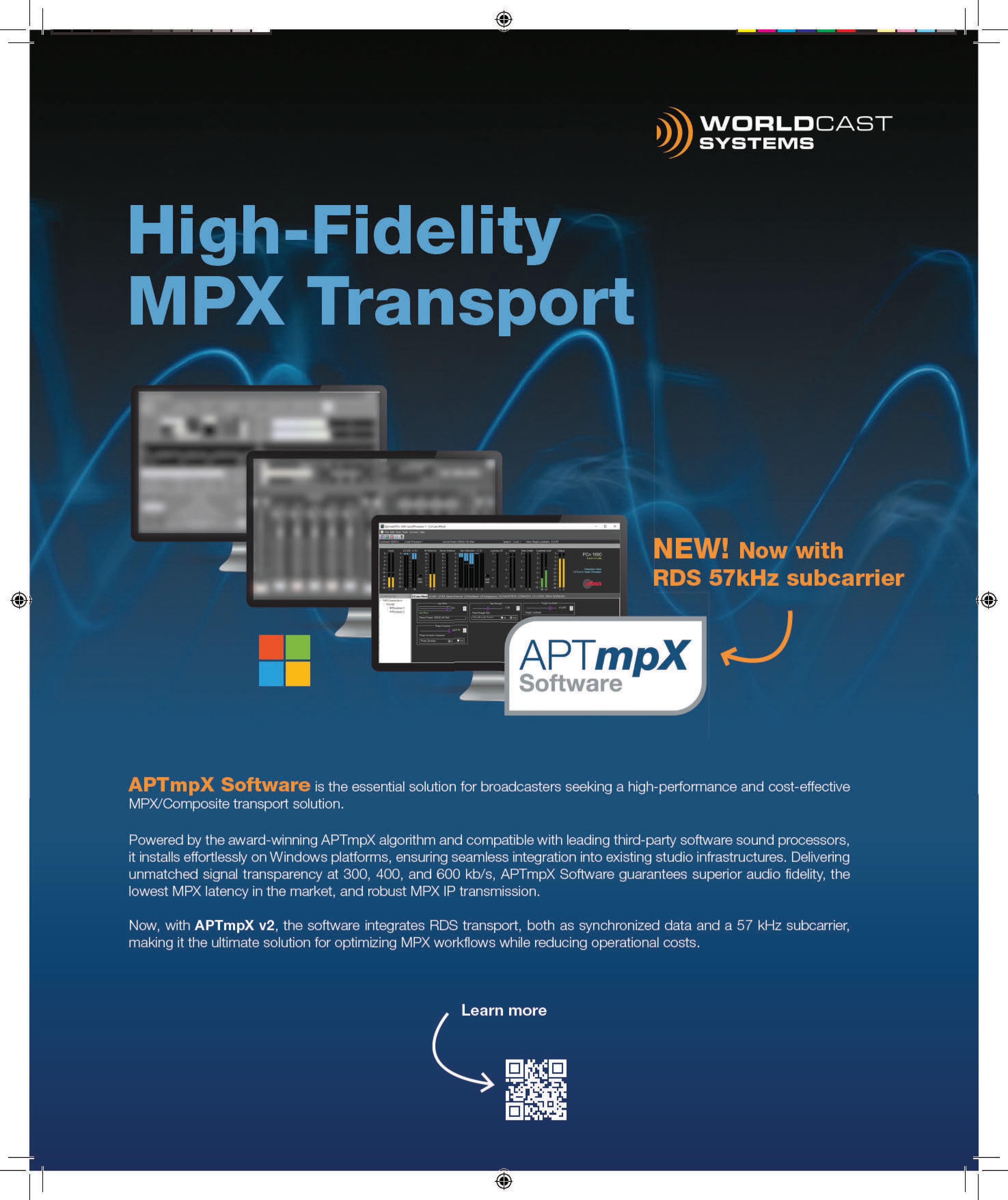

Listeners hear unique programming while the network triggering allows for market-specific IDs
When HD Radio subchannels are used to their full potential, the thrill of discovery can be one of the most exciting elements for longtime fans of radio.
Spanish Broadcast System listeners are being treated to a diversity of musical options over their HD Radio subchannels, including a hybrid regional Mexican and urban format called La Privada, running on two separate HD2 subchannels.
La Privada’s program feed is generated at SBS’ Los Angeles studios, home to 96.3 KXOL(FM) and 97.9 KLAX(FM), and delivered to each of its eight other markets across the U.S. and Puerto Rico. GatesAir’s Intraplex IP Link audio over IP codecs support the multisite networking, moving the La Privada program feed over mostly private fiber links to transmitter sites in each market.
Mike Tosch, director of engineering at SBS, said the channel was launched in two phases, beginning with a local broadcast on KLAX in 2024. As funding for the operation was approved, SBS added new stations in its additional markets.
The design of the IP Link, which is able to take in a contact closure from SBS’ automation, allows each station to trigger local IDs.
Tosch is a longtime Intraplex user. He launched the network with a pair of IPL-100c codecs for the KLAX feed.
The IPL-100c is GatesAir’s first half-rack codec, often used for both STL links and remote contribution devices. He later installed an IPL-200n dual-channel codec at the origination point, and deployed IPL-100n codecs to all nine transmitter sites, including KLAX, replacing the IPL-100c.
The IPL-100n allows for audio insertion for marketspecific legal IDs via network triggering.
Tosch said SBS can add 10 destination points to the IPL-200n, and the company plans to fill the 10th slot with a Chicago feed at a new transmitter site. SBS uses Opus for its Puerto Rico feed, where fiber is 10 times the cost compared to the U.S. mainland. Tosch said it allows the feed to be compressed for transport over public internet while maintaining audio quality.
“We keep it all on HD2 with one single feed, which helps us maintain consistent branding in each market,” he said.

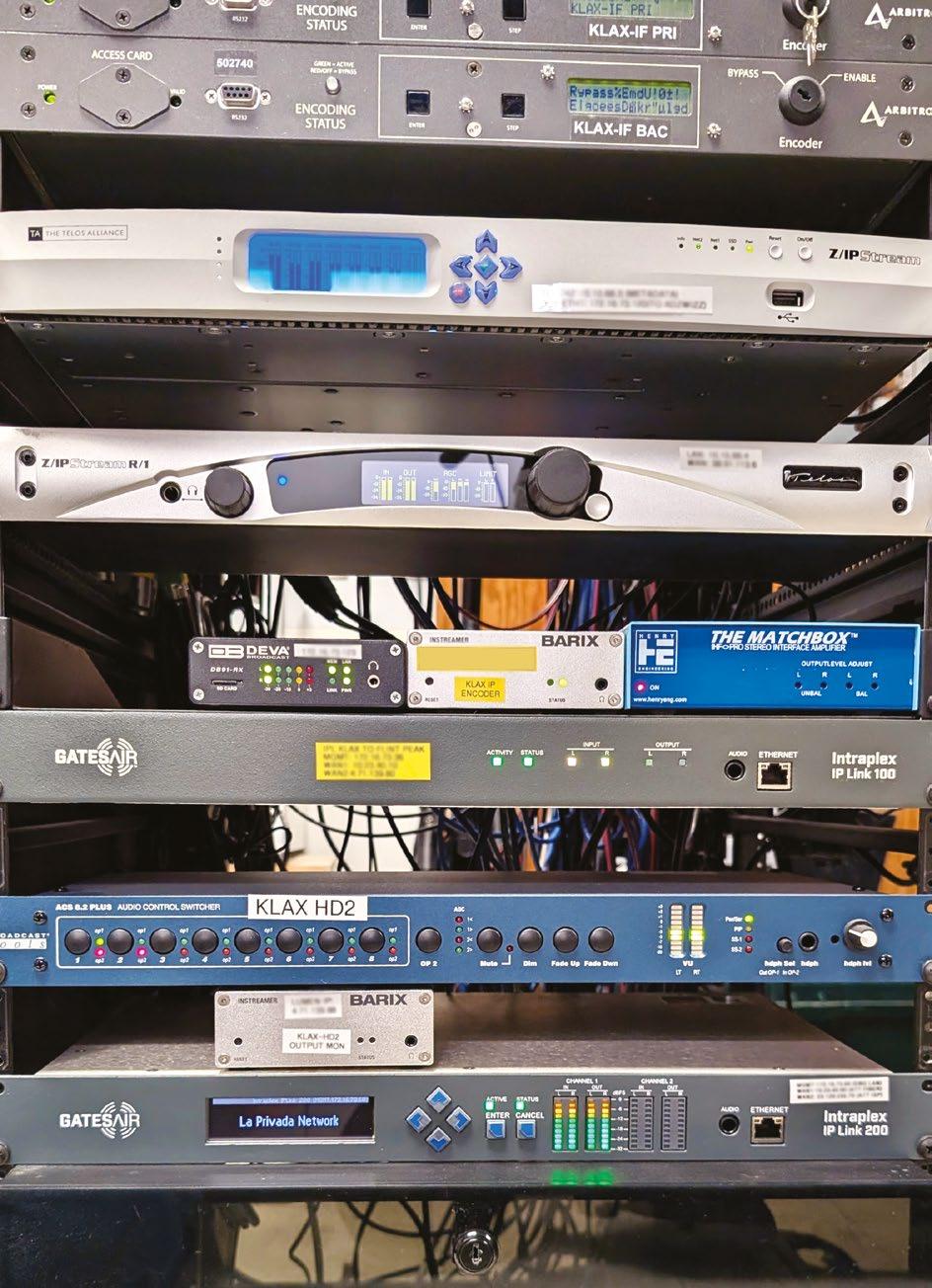
From sports broadcasts to marketing, the group converts its stations to AoIP
Leighton Media, based in St. Cloud, Minn., owns approximately three dozen radio stations in Minnesota and North Dakota, and has expanded into multimedia marketing.
“Instead of having to make multiple stops for traditional radio, digital and promotional marketing, the client leaves it to us to manage a strategy for their brand,” said Tony Abfalter, the company’s director of engineering and IT.
Abfalter became familiar with Comrex from his work for Entercom in the Milwaukee and Madison markets. Now in his role at Leighton, Abfalter frequently has deployed Comrex products, including many Opals and BRIC-Links.
The bulk of Leighton Media’s remote broadcasts involve high school athletics. Abfalter said that in one of its markets, it’s not uncommon for all four of its stations to be covering sports on the same night.
For remote broadcasts, Leighton deploys various Comrex Access Portable models, including its latest Access NX. Out in the field, the units are paired with Comrex’s CrossLock VPN technology, which allows for multi-network usage and real-time management.
Leighton also uses Comrex’s Switchboard Traversal Server, which operates as an address book and makes connections between Comrex IP codecs easier over the internet. Abfalter praised the ability to manage the server remotely and assign a codec out in the field. “It is so much better than having to manually program each codec,” he said.
Abfalter relies on Comrex BRICLinks for Leighton’s STLs. Used

in conjunction with a few older models that have been running steadily, Abfalter likes the addition of front-panel controls to the latest BRIC-Link III. “We send three or four programs from our St. Cloud market out to other stations, and we use the buttons to trigger contact closures,” he said.
With all of his stations now using AoIP systems, Abfalter has also installed Access MultiRack, a multi-
channel IP audio codec capable of five simultaneous stereo connections. It is AES67-compatible and integrates with Wheat-Net.
Reflecting on his initial experience with Comrex equipment in Wisconsin, Abfalter emphasized his current reliance on their products at Leighton.
“The BRIC-Links and Access units have saved my bacon so many times in my career it’s not even funny,” he said.

Former FCC Commissioner Nathan Simington joined the Hudson Institute’s Center for the Economics of the Internet as a visiting fellow. The institute, a conservative think tank in Washington, looks to “guide policymakers and global leaders in government and business through a robust program of publications, conferences, policy briefings and recommendations,” according to its website. …
Sarah Foss departed Audacy and her CTO role in May. Steve Rollins was hired as its chief information officer.


“Steve will work closely with CFO Rick Rosenthal and others to align our technology with our business and operations needs,” an Audacy spokesman said. “As part of his duties, he will oversee all IT and technical operations.” He has also worked at SESAC Companies and Reed Elsevier.
Foss joined what was then Entercom in 2020 as CIO and became CTO the next year. Prior roles include stints at Freewheel, Imagine Communications, Encompass Digital Media, Harris Corp. and PBS. …
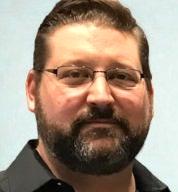
Triple Helix
Technologies named Adam Robinson as its director of sales, marketing and business development. He was most
recently vice president of operations at DJB Radio Software. He is also active with the Central Canada Broadcast Engineers and the Society of Broadcast Engineers. …
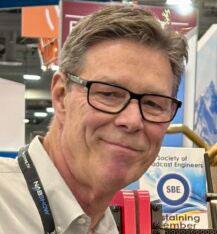
Gary Luhrman announced his retirement from Inovonics. He said he’ll spend more time with family and pursuing creative interests.
He joined Inovonics in 2015 after 15 years in Spain, where he was country manager for BBC World Service Television. …
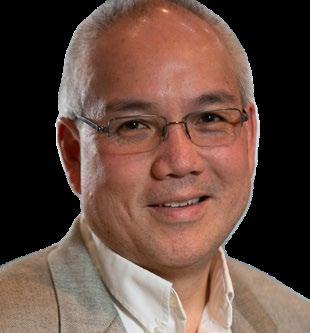
Broadcast Supply Worldwide named Raul Hun as its director of business deployment for southern markets in the United States. Hun joins BSW from Comrex, where he served as sales director for Latin America and Canada. He also has held senior sales roles at Telos Alliance and Broadcast Electronics.
Send announcements for People News to radioworld@futurenet.com.


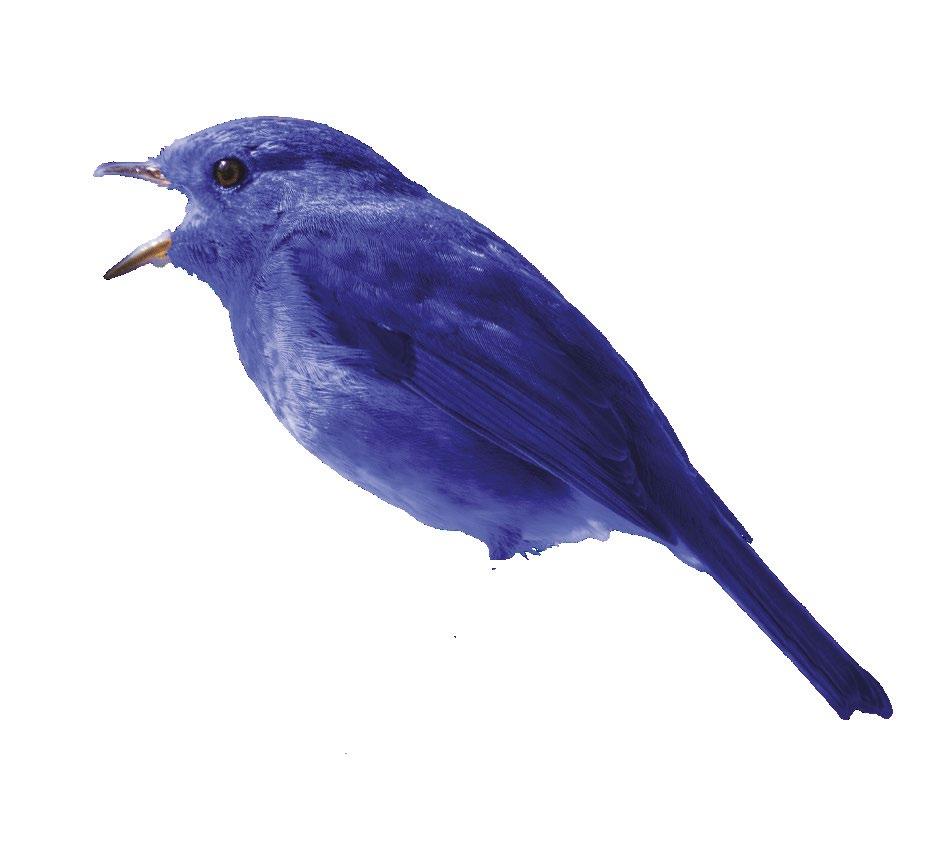










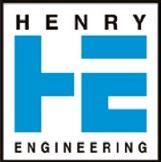











began to rent evening time from a community radio station so that students could have a more authentic experience.
Eventually the school district purchased the station and invested in studio space and professional-grade equipment, changing the call letters to WGBK. In the decades since, the radio program has grown through increased class enrollment and extracurricular involvement.
News & Sports Broadcasting (N&S) is one of the courses. It focuses on training students as journalists, writers, producers and performers. As journalists, students produce interviews with student athletes and coaches, while also seeking interviews with local, national and sometimes international newsmakers.
As writers, students are required not only to write and edit broadcast scripts, but to use correct broadcast news
school sports.
Producing, writing and even hosting programs lend themselves to repetitive classroom practice and regular feedback. Students have access to the three Mac-based production suites using Adobe for audio and different word processing programs for writing.
The main broadcast studio allows students to either go live on 88.5 FM, to broadcast only on the web stream or to operate in audition to practice in the studio.
While important, these experiences don’t necessarily lend themselves to helping students to see early that the power of radio is immediacy and mobility.
At the high school level, live sports broadcasts provide most of the earliest remotes in which young broadcasters get involved. With basic equipment and a cell or WiFi connection, students can bring their audience along to
other places to experience in realtime what might be more difficult with other media.
To get students “out there” broadcasting, the Glenbrook South N&S students provide radio broadcasts of football and baseball games.
Announcing live games requires students to step outside of the school day. This causes some challenges. Because of team schedules and students’ responsibilities, the number of students who can get involved is limited, as is the number of experiences that each student can be offered. Consequently, the students don’t get the repetition necessary for developing skills in live event coverage.

What is needed is a simulation that allows students to make mistakes, repeat performances and take risks without the fear of making errors during a live event.
It didn’t take long to realize that playing video games and having students provide play-by-play of virtual games could provide a safe, familiar and motivating way to simulate live remotes. Most students in the N&S classes are familiar with playing sports video games on popular game consoles (we use an old Sony PlayStation).
Also, games’ settings allow us to change time and slow down games. Finally, games can be reset, which allows students to repeat performances, while also having the benefit of being fairly random (opposed to using taped games) because the games are played live.
The setup is not complicated. Students are organized into groups of four with color and play-by-play announcers in the front two seats and the video game players in the back. Games are set with two-minute quarters, and the players skip over the in-game timeouts. The goal is to have as many teams rotate through announcing and playing the game as possible.
Announcers wear broadcast headsets hooked to a PA system so the classroom can hear the play calling. The announcers’ audio is returned through a headphone amplifier so the play callers can hear themselves in their headsets. The entire setup fits on an old AV cart!
The practice usually begins with two skilled students setting the example for how play-by-play and color work together in a radio broadcast. The focus is on being descriptive and painting a picture.
Many students default to a more conversational style, while neglecting information radio listeners can’t see, such as time and score, announcer names and station
Above Students call a simulated game.
How to submit Radio World welcomes comment on all relevant topics. Email radioworld@ futurenet.com with “Letter to the Editor” in the subject field.
identification. Most students only watch sports, so radio style game announcing takes practice!
It doesn’t take long, though, for students to “feel” the differences between “radio style,” which is sharing with listeners what they need to create their own pictures, and “TV style,” which is much more of a conversation under game film.
Novice broadcasters are paired with skilled game announcers. Each partner gets a chance to broadcast play-by-play for a two-minute quarter while the other provides brief color commentary. The limited time pushes the students to be concise.
When partners have completed their turns announcing, they move to playing the game. With an entire group of classmates watching, there is a fairly natural exchange of what the group liked and didn’t like about a particular announcing team’s style. With teacher guidance, a system of feedback, usually positive, develops.
The video game approach brings benefits as an instructional tool. Bames support a simulation that allows students to get an approximation of a real-world experience. The simulation is motivating and adds the convenience of stopping a game in progress to allow the instructor to comment on what students are doing, and to allow students to reflect on their own practice.
Students can make errors without fear of major on-air mistakes like freezing during a live broadcast or making larger mistakes like forbidden “slips of the tongue.” It’s better to learn to control frustration in a classroom than to “earn” a fine from the FCC for language.
Admittedly, there are limitations. Students have to rotate through the process quickly because of class schedules and the need to address other topics and complete other projects. Even the most focused student can get bored and want to view playing video games as “playtime,” without focusing on the intended purpose.
Finally, nothing replaces real-world experience. Arguably, calling video game sports is really best used to give students an introduction into live sports broadcasting so that getting behind the mic during a live event is not a completely unfamiliar experience.
Over several years, student feedback has been positive. For the most part, students have viewed the in-class playby-play practice positively. They’ve commented that it helps to have practice before heading to the football stadium or sitting at half court. Even the students who have no time or inclination to broadcast live games enjoy the exercise. Who wouldn’t like to play video games in class?

